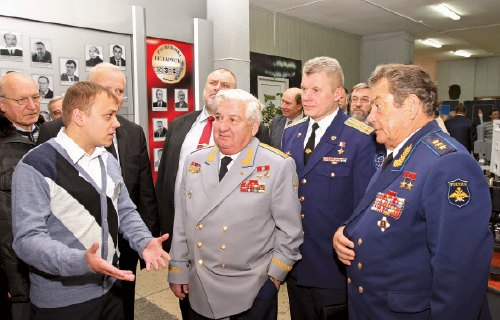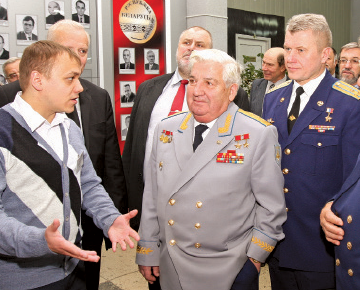Space exploration is not just a matter of prestige, but of vital importance. In launching its satellite, Belarus has joined space states and is actively developing this sphere.
The 6th Belarusian Space Congress, hosted by the National Academy of Sciences, was symbolic in gathering not only leading experts in this high-tech area, but, for the first time, real hero astronauts: Piotr Klimuk, Vladimir Kovalenok and Oleg Novitsky — all from Belarus.

Pilot cosmonauts Piotr Klimuk, Oleg Novitsky and Vladimir Kovalenok meet National Academy of Sciences experts
In exploring space, we master new technologies, which promote wider economic and scientific development, as our first cosmonaut, Piotr Klimuk, would agree.
The exhibition of scientific and technical space equipment produced by the United Institute of Informatics Problems (UIIP) of the NAS — where the congress took place — impressed Mr. Klimuk, who emphasised, “Equipment made in Belarus is among the most advanced. On my mission, we used a spectrometer made by the Institute of Physics, which helped us collect so much information! We now have good optics and a system of Earth remote sensing, helping us address issues in ecology, meteorology, cartography, and other Earth studies. We’ll soon be launching a communications satellite. Space has much to offer. Earth resources are limited, so we should aspire beyond.”

Minsk exhibition of space sci-tech goods
Programmes directed at developing space activity involve about 50 organisations from Belarus and Russia. Among the most active are: Peleng JSC — whose orientation device was launched this year on Russia’s Meteor satellite; Integral JSC; various institutes within the Academy of Sciences; and the Belarusian State University. The Institute of Applied Physical Problems (at the Belarusian State University) has been working with the Russian Academy of Sciences to study circumterraneous space — looking at the Earth and its atmosphere.
The Director of the Institute, Piotr Kuchinsky, tells us with some pride, “One of our developments is the photospectral system, which has been used for the past three years on the International Space Station (ISS). It allows precise photos to be taken of the Earth. We’re also responsible for a panel of detectors mounted on the outside of the ISS. Another, more advanced multipurpose spectral system has now passed tests and is prepared for launch; we hope that, in a month or two, it will also be operational at the station.”
Immediate tasks for Belarus’ space programme include perfecting the system of remote Earth data collection, including launching a new satellite which can receive pictures at a higher resolution, and developing new materials, equipment and technologies.











